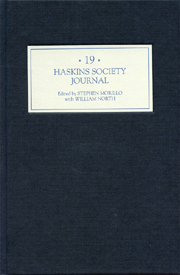Book contents
- Frontmatter
- Contents
- Editor's Note
- Abbreviations
- 1 King Harold's Daughter
- 2 The Anglo-Saxon Chronicles, Identity and the Making of England
- 3 Master Arnulf, Archdeacon of Rouen, Unlicensed Pluralism, and Idoneitas. Defining Eligibility in the Early Thirteenth Century
- 4 The Saint Zenobius Dossal by the Master of the Bigallo and the Cathedral Chapter of Florence
- 5 Discovering the Aquitanian Church in the Corpus of Ademar of Chabannes
- 6 Robert de Londres, Illegitimate Son of William, King of Scots, c.1170–1225
- 7 The Use of Naval Power in the Norman Conquest of Southern Italy and Sicily
- 8 Apology, Protest, and Suppression: Interpreting the Surrender of Caen (1105)
- 9 Henry Loyn and the Context of Anglo-Saxon England
4 - The Saint Zenobius Dossal by the Master of the Bigallo and the Cathedral Chapter of Florence
Published online by Cambridge University Press: 12 September 2012
- Frontmatter
- Contents
- Editor's Note
- Abbreviations
- 1 King Harold's Daughter
- 2 The Anglo-Saxon Chronicles, Identity and the Making of England
- 3 Master Arnulf, Archdeacon of Rouen, Unlicensed Pluralism, and Idoneitas. Defining Eligibility in the Early Thirteenth Century
- 4 The Saint Zenobius Dossal by the Master of the Bigallo and the Cathedral Chapter of Florence
- 5 Discovering the Aquitanian Church in the Corpus of Ademar of Chabannes
- 6 Robert de Londres, Illegitimate Son of William, King of Scots, c.1170–1225
- 7 The Use of Naval Power in the Norman Conquest of Southern Italy and Sicily
- 8 Apology, Protest, and Suppression: Interpreting the Surrender of Caen (1105)
- 9 Henry Loyn and the Context of Anglo-Saxon England
Summary
In the early thirteenth century, the cathedral chapter of Florence was not getting along with its bishop. This was nothing out of the ordinary, to be sure: discord between chapters and bishops erupts in evocative clusters of parchments in ecclesiastical archives throughout Italy across the central Middle Ages. Such documents seethe with what the late Robert Brentano, in the case of Rieti, called ‘antiepiscopal fury’. What is striking in the case of the thirteenth-century Florentine chapter was how artfully the canons expressed their discontent. The Dossal, or altarpiece, of St Zenobius (Fig. 1) attributed to the Master of the Bigallo is one artifact of this canonical mood. At its center is the enthroned figure of Zenobius, who was the earliest known bishop of Florence, flanked by two other clerics, SS Eugenius and Crescentius. Four images depicting miracles of St Zenobius complete the panel. Now held by the Museo dell'Opera del Duomo in Florence, and presently undergoing restoration, the panel painting is important evidence for the chapter's promotion of the cult of this early bishop of the city. It is very likely related to two other monuments to Zenobius: the Pseudo-Simplicianus vita and the section of the ritual of episcopal entry into the city that commemorates the saint's chief miracle and orchestrates the veneration of his relics. All of these artifacts of devotion to Saint Zenobius are best understood within the historical context of the chapter's relations with the see.
- Type
- Chapter
- Information
- The Haskins Society Journal 192007 - Studies in Medieval History, pp. 65 - 81Publisher: Boydell & BrewerPrint publication year: 2008



